


Sharpening for Turners with Hal Simmons
Sunday, March 19
9am-5pm
Class Size: 8
Tuition: $95
Item# 991338
 2-Day Bowl Turning Workshop with Frank Bowers
2-Day Bowl Turning Workshop with Frank Bowers
Saturday & Sunday,
March 25 & 26
9am-5pm
Class Size: 8
Tuition: $195
Item# 991331
 Stains vs. Dyes
Stains vs. Dyes
Every quarter I teach a class on coloring wood and often the very first question from the class is, "What are the differences between stains and dyes?"
Very simply put, stains are very thin paints and dyes are why your socks are red out of the washer. With stains, the pigment tends to remain on the surface of the wood and lodge in the pores, while dyes penetrate deeply and color the wood from within.
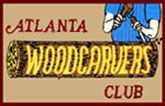
For 30 years the Atlanta Woodcarvers Club has been dedicated to providing information and education about chip, relief and in-the-round carving and finishing techniques to woodcarvers of all skill levels and experience. Please come join us at one of our monthly meetings:
2nd Tuesday of every month @ 7:00PM
Mason Mill
Dept. of Recreation
(Lower level of
Mack Love Center)
1340 McConnell Drive
Decatur, Georgia 30033
Visit our website for more information: www.atlantawoodcarvers.com .
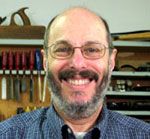
Bob Flexner has operated his own furniture making and restoration shop in Norman, OK for 30 years. For the last 15 years, he has taught wood finishing and restoration. His accomplishments include writing the authoritative and best-selling book, Understanding Wood Finishing (203621), now in its second, fully revised edition, editing Finishing and Restoration (Professional Refinishing) magazine, making the award-winning videos, Repairing Furniture and Refinishing Furniture for Taunton Press, and writing the long-running columns "Finishing" in Woodshop News and "Flexner on Finishing" in Popular Woodworking . Bob is probably best known for defining the products used in wood finishing and organizing them into categories that make them easily understandable.
We are excited to announce that Bob will be returning to Highland Hardware on May 6 & 7 to conduct a extensive 2-day seminar on finishes, Understanding Wood Finishing (Class# 991357). The emphasis of the seminar will be on understanding how stains and finishes work, how to choose among them and how to apply them. Subjects to be covered include preparing the surface for finishing, using pigment and dye stains, sealing, pore filling, glazing, toning, applying wipe-on and film-building finishes, spray guns, French polishing, rubbing a finish and caring for a finish. Oil, varnish, shellac, lacquer, catalyzed finishes and water-based finishes will be covered. Special attention will be paid to solving all the most common problems that occur in finishing, including blotching, bleeding, orange peel, brush marks, fisheye, dust nibs, runs and sags, and improper curing. As a sneak preview, Bob has provided the tip below.
A Perfect Finish
by Bob Flexner
What is it that makes a perfect finish? Its not the coloring. A lot of factory-made furniture is finished with a sophisticated, multi-step coloring process that still shows flaws when you catch a reflection across the surface or you run your hand over the finish.
A great finish is one that has been rubbed smooth to eliminate the dust nibs, brush marks, orange peel and runs that diminish the visual and tactile experience.
With oil finishes, where you are wiping off the excess, ultimate smoothness is achieved by sanding or abrading each coat while its still wet (before wiping off) using very fine grit sandpaper or other abrasive.
With hard-curing, film-building finishes, improved smoothness is achieved by rubbing with #0000 steel wool and possibly a lubricant. Ultimate smoothness and perfection is achieved by leveling the finish using sandpaper and a backing block or pad, and then rubbing with increasingly fine-grit abrasives until you achieve the sheen you want.
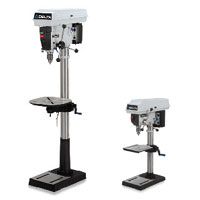
After the incredible success (it was our most viewed piece) of Mr. McCandless' prior contribution, Two Simple Table Saw Improvements , published in our November 2005 issue, we are pleased to present another of his helpful and informative articles.
Does Size Matter?
by Richard McCandless
Okay, let's admit it our significant others silently accuse us of feeding our Freudian fixations in the workshop. "You already have one of those," they say, "do you really need a bigger one?" Look around some people's shops and you'll see the more-is-better syndrome at work: duplicate tools, massive motors, and racks of seldom used accessories. Hence the jokes about "He who dies with the most tools wins".

Penturning: A Step-by-Step Primer
by Elena Vega
One of the great benefits of working at Highland Hardware is that one is constantly exposed to new woodworking techniques and skills. I became interested in woodturning after watching a co-worker turn a pen on his lunch break one day. The next day I tried
my
hand at it on
my
break, and I was hooked! Luckily, Christmas was right around the corner, so I asked for a
Jet Mini Lathe
(141582). Santa was kind enough to bring it, and soon I was turning all different kinds of pens.
Turning a pen is an ideal introduction to woodturning. A pen is one of the easiest, yet most attractive items you can produce - you get virtually instant gratification.
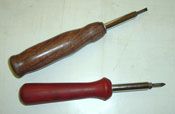
We invite you to participate in the Highland Hardware Turning Contest, featuring our new 4-in-1 Screwdriver Kits (161960). The contest rules and guidelines are as follows:
Highland Hardware Turning Contest Online Entry Form
Highland Hardware Turning Contest Entry Form (Print Version to Mail In)
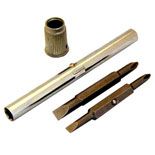
4-in-1 Screwdriver Kit
$5.99
Use your choice of wood make a truly unique gift for a client, friend or yourself. This kit includes the bushing, tube and two double-ended screwdriver bits (one is #1 & #2 Phillips, the other is small & large slotted.) The kit requires a wood blank approximately 1-1/2" x 1-1/2" x 6". You will also need 16mm & 1/2" drill bits. Instructions included.
Item# 191960.